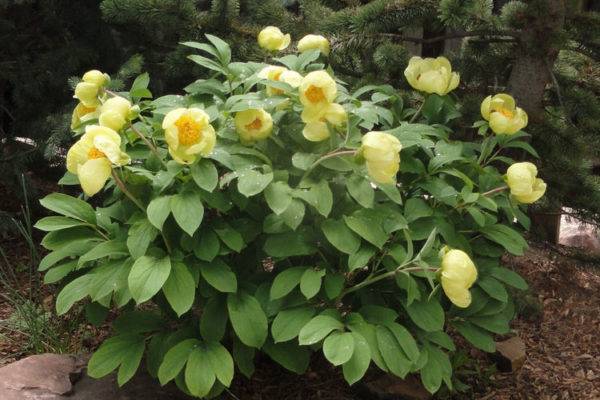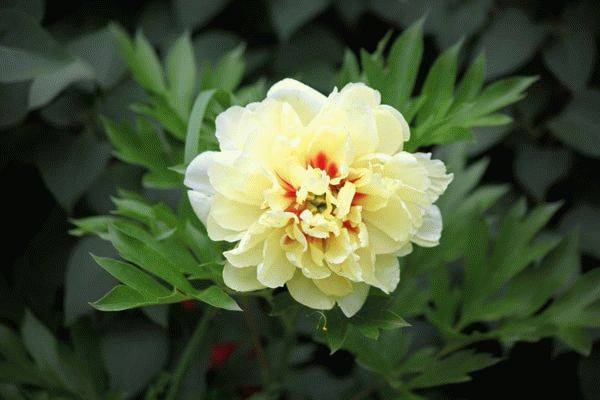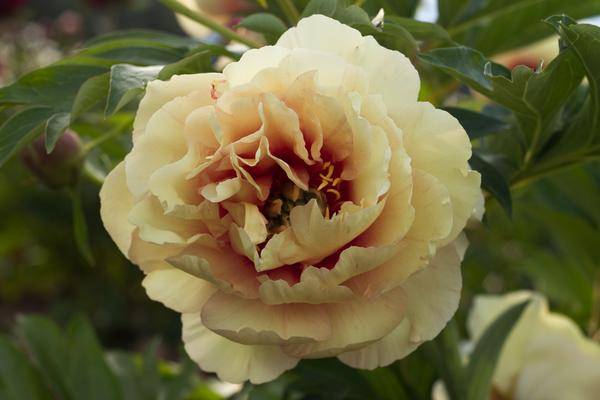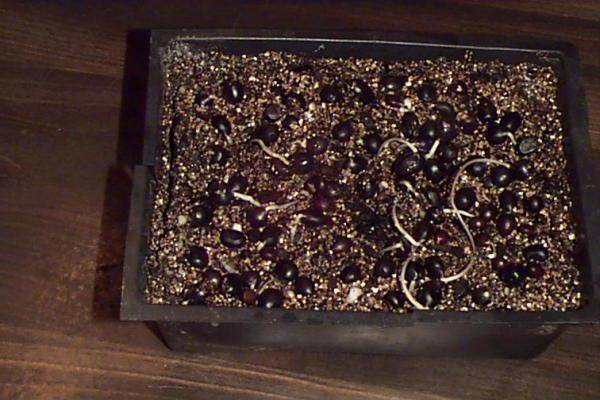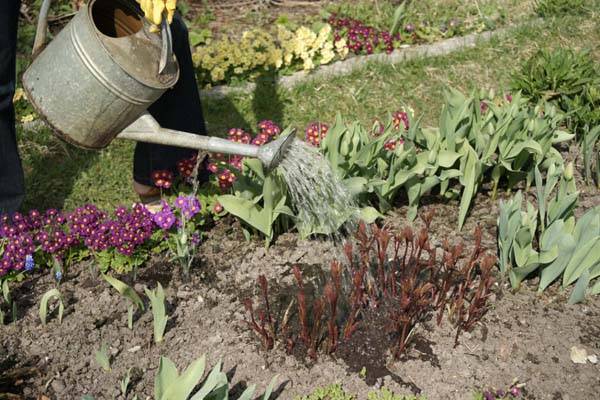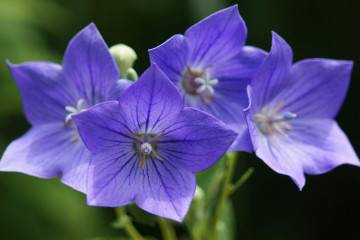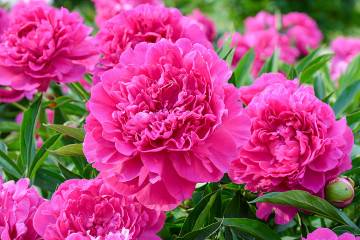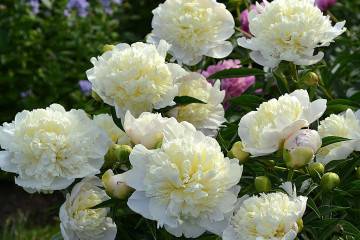Yellow peonies - the best varieties and care for them
Content:
Peonies of the yellow variety arose as a result of crossing the tree and herbaceous subspecies. The work was carried out by T. Ito (Japan) in the 50s. last century. From his surname, the name of the resulting group of flowers originated - ITO-hybrids.
Yellow peonies: a short description, characteristics
The culture grows up to 1 m, has a dark green foliage. In late autumn, the aboveground part of the plant dies off.
Use in landscape design
Peonies of lemon color and other shades are used to decorate the infield. Due to the variety of colors, you can choose a variety for any style of landscape design.
Classification of yellow peonies and varieties that are in greatest demand among gardeners
Plants are subdivided into herbaceous, treelike and hybrid subspecies.
Herbaceous
Peony herbaceous yellow is characterized by the preservation of the color of the petals throughout the entire flowering.
Lemon Chiffon
It has semi-double buds with a yellow-lemon color. It grows up to 70 cm, flowering time is average.
Golden chariot
Differs in strong straight stems, up to 90 cm high. The foliage is yellow-green, and the roots and buds are yellow.
Golden halo
It grows up to 75 cm. In densely double flowers, the central petals are painted in a yellow tint, towards the end - in cream.
Sunny Boy Terry
A rare species with creamy yellow flowers. The height of the bush does not exceed 75 cm.
Golden Wheel
The variety has greenish-yellow buds, foliage, roots and buds. The maximum height of the bush is 0.9 m.
Sunny Girl
Shrub 0.9 m high is covered with pale yellow buds of a dense double type.
Gold Mine
It has double flowers of a golden hue, grows up to 80 cm.
Tree-like
Deciduous shrubs come in many varieties.
Midday Heat
It grows up to 1.2 m, has large flowers of a delicate lemon shade. A purple spot is located in the center of the bud. The flowering period does not exceed 2 weeks.
Yellow Yao
Frost-resistant variety up to 2 m high. Bright yellow buds up to 70 pcs. on the same bush are combined with an unusual foliage shape.
Gold Placer
It will grow up to 1.5 m, it is distinguished by spherical yellow flowers, casting a peach shade. On the tips of the petals there is a pinkish border. Flowering begins in the last week of May.
Academician Sadovnichy
It is characterized by a height of up to 1 m, semi-double buds with red-purple stamens. The petals are bright yellow.
Souvenir de Maxime Cornu
A short shrub has flowers with a pinkish-cream edging, appearing by mid-July.
Kuindzhi
It grows up to 1.3 m, the petals of a solid yellow color are wavy at the edges. They are arranged on a flower in 2 or 3 rows.
Hybrid
They have the characteristics of the previous two types.
Viking Full Moon
On a herbaceous bush, greenish-yellow flowers with a burgundy disc in the middle.
Bartzella
Compact shrubs up to 70 cm in height. In May or June, they are covered with golden buds up to 22 cm in diameter.
Going Bananas
Lush plants up to 65 cm with large (up to 24 cm in diameter) simple buds. The petals have a banana color.
Singin 'in the rain
A dense bush grows up to 85 cm, semi-double flowers of a pink type.
Canary Diamonds
Huge buds with a yellow-peach tint are located on strong peduncles. The plant needs a transplant only after 10 years.
Border Charm
The one and a half meter shrub resembles the Bartzella variety in appearance. With proper care, flowering will be abundant.
Yellow Crown
A low-growing plant, not exceeding 60 cm, with large yellow flowers and a reddish spot in the middle.
Growing a flower
In the description of any variety, complete information is given about the rules for planting and possible difficulties with growing, however, for all varieties, almost everything is standard.
Planting by root cuttings
The bush is dug in and taken out of the ground. The root system is washed with water and left to dry for several hours. This approach will help reduce fragility and accidental damage.
Seat selection
Plants should not be planted near houses, fences, large trees. If the site is located in an area with closely located groundwater, then the bushes are planted in raised beds or create good drainage.
How to prepare the soil and flower for planting
The landing pit is being prepared several weeks before the target date. It is dug up to 60 cm deep, up to 70 cm wide.
Planting procedure step by step
The prepared bush is divided into several parts with 3-5 buds and part of the root system up to 15 cm. Violation of the rules will lead to a lack of flowering. Further procedures are carried out according to the algorithm:
- The seedling is sent to a potassium permanganate solution for disinfection for half an hour.
- Then it is immersed in a solution of heteroauxin - 1 tablet is diluted in 10 liters of water.
- After extraction, allow to dry, the cut sites are covered with crushed coal.
- In the hole, the bush is planted on a prepared soil pillow.
- The free space is covered with earth; above the kidneys, the layer should not exceed 5 cm.
- Watering.
Planting with seeds (for breeding)
Seed propagation is practically not used by amateurs. When sowing, most of the varietal traits disappear, the flowers acquire a different appearance than that of the mother plant.
When seeds are planted in open ground, their germination can occur for 2-5 years. The material collected in the fall needs urgent sowing (the depth of the holes is about 5 cm).
When landing in boxes, warm and cold stratification is carried out. The seed will take 3 months to germinate.
Care for yellow varieties
With proper care, the plant will avoid diseases, it will bloom on time.
Watering and feeding
Frequent watering is done during and after flowering. Wells are formed around the bush, allowing the root system to absorb water faster.Finish frequent watering in the last week of August after the buds have dried. Then watered no more than once a month.
Fertilize the plantation three times per season:
- for the first time after the snow melts, a hole is formed around the bushes, which is poured with a pinkish solution of potassium permanganate;
- the second time after the appearance of short shoots. Fertilized with nitrogen and potassium solutions, you can use potassium salt, ammonium nitrate or rotted manure;
- the third time, 2 weeks before flowering, the plant is enriched with phosphorus, nitrogen and potassium dressings.
Mulching and loosening
They loosen and mulch the earth to provide the roots with air flow, reduce the rate of evaporation of water. The process is combined with watering.
Preventive treatment
The rules are simple:
- complete removal of shoots in autumn;
- antifungal additive of natural furnace ash in the soil during planting;
- reduction of acidification of the earth with lime or dolomite flour;
- spraying shrubs with 1% Bordeaux liquid.
Blooming yellow peonies
The variety has large flowers reaching 17-20 cm in diameter.
A period of activity and rest
The plant is covered with buds in May-June, the duration of flowering ranges from 9 to 14 days.
Care during and after flowering
The culture needs competent watering and preliminary, 2 weeks before the formation of buds, top dressing. After the buds wither, they are cut off.
What to do if it does not bloom
The lack of flowers is associated with:
- with a young age of the bush;
- incorrect, deep fit;
- insufficient or excessive watering;
- attack of insect pests.
Peonies after flowering
After the buds dry, gardeners begin transplanting, pruning and preparing for the winter period.
Transfer
Transferring to another place is often combined with dividing the bushes. The procedure is carried out according to the standard algorithm, after which the plant needs systematic watering.
Pruning
The flowers are excised before the first leaves after wilting, the shoots are not touched for a month, at this time the buds of future buds are laid.
Preparing for winter
With the onset of September, a complete pruning of the shrub is carried out. Remains harbor:
- sawdust;
- dry peat;
- foliage.
Diseases, pests and ways to control them
Common diseases include:
- rust. Requires spraying the bush with 1% Bordeaux liquid and excision of the affected foliage;
- gray rot. Therapy consists in using a 0.6% suspension of thiram;
- mosaic. There is no cure, all infected bushes are destroyed.
The main parasites of the plant are bronzes, ants, thrips, and the hop worm. To destroy them, insecticidal solutions are used.
Yellow peonies will decorate the garden only with proper care and timely watering. Unpretentious plants rarely need help. The problem can only arise during pest attacks or before the onset of winter.
